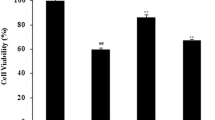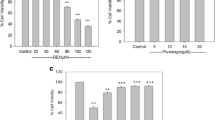Abstract
The inhibition of proliferation or functional alteration of osteoblasts by glucocorticoids (GCs) has been recognized as an important etiology of GC-induced osteoporosis (GIO). Connexin 43 (Cx43) is the most abundant connexin isoform in bone cells and plays important roles in bone remodeling. Despite the important role of Cx43 in bone homeostasis and the prevalence of GIO, the direct action of GCs on Cx43 expression in osteoblasts has been poorly described. The aim of the present study was to evaluate how GCs affect Cx43 expression in osteoblasts. Dexamethasone (Dex) treatment decreased expression of Cx43 RNA and protein in MC3T3-E1 mouse osteoblastic cells. Reduction of Cx43 expression by Dex was dependent on the glucocorticoid receptor (GR), as it was abolished by pretreatment with a GR blocker. Treatment with PTH (1–34), a medication used for GIO management, counteracted the suppression of Cx43 by Dex. Akt or mTOR signaling modulators revealed the involvement of the Akt/mTOR signaling pathway in Dex-induced reduction of Cx43 expression. Moreover, overexpression of Cx43 significantly attenuated Dex-inhibited cell viability and proliferation, as evidenced by MTT and bromodeoxyuridine (BrdU) incorporation assay of MC3T3-E1 cells. To account for possible species or cell type differences, human primary osteoblasts were treated with Dex and similar downregulation of Cx43 by Dex was observed. In addition, immunofluorescent staining for Cx43 further demonstrated an apparent decrease in Dex-treated human osteoblasts, while analysis of lucifer yellow propagation revealed reduced gap junction intercellular communication by Dex. Collectively, these findings indicate that GCs suppress Cx43 expression in osteoblasts via GR and the Akt/mTOR signaling pathway and overexpression of Cx43 may, at least in part, rescue osteoblasts from GC-induced reductions in proliferation.





Similar content being viewed by others
References
Ferris HA, Kahn CR (2012) New mechanisms of glucocorticoid-induced insulin resistance: make no bones about it. J Clin Invest 122:3854–3857
Shi J, Wang L, Zhang H, Jie Q, Li X, Shi Q, Huang Q, Gao B, Han Y, Guo K, Liu J, Yang L, Luo Z (2015) Glucocorticoids: dose-related effects on osteoclast formation and function via reactive oxygen species and autophagy. Bone 79:222–232
Briot K, Roux C (2015) Glucocorticoid-induced osteoporosis. RMD Open 1:e000014
Kanis JA, Johansson H, Oden A, Johnell O, de Laet C, Melton IL, Tenenhouse A, Reeve J, Silman AJ, Pols HA, Eisman JA, McCloskey EV, Mellstrom D (2004) A meta-analysis of prior corticosteroid use and fracture risk. J Bone Miner Res 19:893–899
Manolagas SC (2010) From estrogen-centric to aging and oxidative stress: a revised perspective of the pathogenesis of osteoporosis. Endocr Rev 31:266–300
Civitelli R (2008) Cell-cell communication in the osteoblast/osteocyte lineage. Arch Biochem Biophys 473:188–192
Frenkel B, White W, Tuckermann J (2015) Glucocorticoid-induced osteoporosis. Adv Exp Med Biol 872:179–215
O’Brien CA, Jia D, Plotkin LI, Bellido T, Powers CC, Stewart SA, Manolagas SC, Weinstein RS (2004) Glucocorticoids act directly on osteoblasts and osteocytes to induce their apoptosis and reduce bone formation and strength. Endocrinology 145:1835–1841
Matsuuchi L, Naus CC (2013) Gap junction proteins on the move: connexins, the cytoskeleton and migration. Biochim Biophys Acta 1828:94–108
Civitelli R, Beyer EC, Warlow PM, Robertson AJ, Geist ST, Steinberg TH (1993) Connexin43 mediates direct intercellular communication in human osteoblastic cell networks. J Clin Invest 91:1888–1896
Plotkin LI, Bellido T (2013) Beyond gap junctions: connexin43 and bone cell signaling. Bone 52:157–166
Pacheco-Costa R, Davis HM, Sorenson C, Hon MC, Hassan I, Reginato RD, Allen MR, Bellido T, Plotkin LI (2015) Defective cancellous bone structure and abnormal response to PTH in cortical bone of mice lacking Cx43 cytoplasmic C-terminus domain. Bone 81:632–643
Lloyd SA, Loiselle AE, Zhang Y, Donahue HJ (2013) Connexin 43 deficiency desensitizes bone to the effects of mechanical unloading through modulation of both arms of bone remodeling. Bone 57:76–83
Paznekas WA, Boyadjiev SA, Shapiro RE, Daniels O, Wollnik B, Keegan CE, Innis JW, Dinulos MB, Christian C, Hannibal MC, Jabs EW (2003) Connexin 43 (GJA1) mutations cause the pleiotropic phenotype of oculodentodigital dysplasia. Am J Hum Genet 72:408–418
Lecanda F, Warlow PM, Sheikh S, Furlan F, Steinberg TH, Civitelli R (2000) Connexin43 deficiency causes delayed ossification, craniofacial abnormalities, and osteoblast dysfunction. J Cell Biol 151:931–944
Lima F, Niger C, Hebert C, Stains JP (2009) Connexin43 potentiates osteoblast responsiveness to fibroblast growth factor 2 via a protein kinase C-delta/Runx2-dependent mechanism. Mol Biol Cell 20:2697–2708
Niger C, Buo AM, Hebert C, Duggan BT, Williams MS, Stains JP (2012) ERK acts in parallel to PKCdelta to mediate the connexin43-dependent potentiation of Runx2 activity by FGF2 in MC3T3 osteoblasts. Am J Physiol Cell Physiol 302:C1035–1044
Shen H, Grimston S, Civitelli R, Thomopoulos S (2015) Deletion of connexin43 in osteoblasts/osteocytes leads to impaired muscle formation in mice. J Bone Miner Res 30:596–605
Bivi N, Condon KW, Allen MR, Farlow N, Passeri G, Brun LR, Rhee Y, Bellido T, Plotkin LI (2012) Cell autonomous requirement of connexin 43 for osteocyte survival: consequences for endocortical resorption and periosteal bone formation. J Bone Miner Res 27:374–389
Civitelli R, Ziambaras K, Warlow PM, Lecanda F, Nelson T, Harley J, Atal N, Beyer EC, Steinberg TH (1998) Regulation of connexin43 expression and function by prostaglandin E2 (PGE2) and parathyroid hormone (PTH) in osteoblastic cells. J Cell Biochem 68:8–21
Chung DJ, Castro CH, Watkins M, Stains JP, Chung MY, Szejnfeld VL, Willecke K, Theis M, Civitelli R (2006) Low peak bone mass and attenuated anabolic response to parathyroid hormone in mice with an osteoblast-specific deletion of connexin43. J Cell Sci 119:4187–4198
Plotkin LI, Lezcano V, Thostenson J, Weinstein RS, Manolagas SC, Bellido T (2008) Connexin 43 is required for the anti-apoptotic effect of bisphosphonates on osteocytes and osteoblasts in vivo. J Bone Miner Res 23:1712–1721
Livak KJ, Schmittgen TD (2001) Analysis of relative gene expression data using real-time quantitative PCR and the 2(−ΔΔC(T)) Method. Methods 25:402–408
Han JH, Kim KA, Shah A, Park BH, Park WH, Kim SH (2010) Regulation of renin release by connexin 43 in As 4.1 cell line. Peptides 31:899–902
el-Fouly MH, Trosko JE, Chang CC (1987) Scrape-loading and dye transfer. A rapid and simple technique to study gap junctional intercellular communication. Exp Cell Res 168:422–430
Satterwhite J, Heathman M, Miller PD, Marin F, Glass EV, Dobnig H (2010) Pharmacokinetics of teriparatide (rhPTH[1-34]) and calcium pharmacodynamics in postmenopausal women with osteoporosis. Calcif Tissue Int 87:485–492
Schiller PC, Roos BA, Howard GA (1997) Parathyroid hormone up-regulation of connexin 43 gene expression in osteoblasts depends on cell phenotype. J Bone Miner Res 12:2005–2013
Mitchell JA, Ou C, Chen Z, Nishimura T, Lye SJ (2001) Parathyroid hormone-induced up-regulation of connexin-43 messenger ribonucleic acid (mRNA) is mediated by sequences within both the promoter and the 3′untranslated region of the mRNA. Endocrinology 142:907–915
Almeida M, Han L, Ambrogini E, Weinstein RS, Manolagas SC (2011) Glucocorticoids and tumor necrosis factor alpha increase oxidative stress and suppress Wnt protein signaling in osteoblasts. J Biol Chem 286:44326–44335
Weinstein RS, Jilka RL, Parfitt AM, Manolagas SC (1998) Inhibition of osteoblastogenesis and promotion of apoptosis of osteoblasts and osteocytes by glucocorticoids. Potential mechanisms of their deleterious effects on bone. J Clin Invest 102:274–282
Kauh E, Mixson L, Malice MP, Mesens S, Ramael S, Burke J, Reynders T, Van Dyck K, Beals C, Rosenberg E, Ruddy M (2012) Prednisone affects inflammation, glucose tolerance, and bone turnover within hours of treatment in healthy individuals. Eur J Endocrinol 166:459–467
Henneicke H, Gasparini SJ, Brennan-Speranza TC, Zhou H, Seibel MJ (2014) Glucocorticoids and bone: local effects and systemic implications. Trends Endocrinol Metab 25:197–211
Grimston SK, Brodt MD, Silva MJ, Civitelli R (2008) Attenuated response to in vivo mechanical loading in mice with conditional osteoblast ablation of the connexin43 gene (Gja1). J Bone Miner Res 23:879–886
Zhang Y, Paul EM, Sathyendra V, Davison A, Sharkey N, Bronson S, Srinivasan S, Gross TS, Donahue HJ (2011) Enhanced osteoclastic resorption and responsiveness to mechanical load in gap junction deficient bone. PLoS ONE 6:e23516
Stains JP, Watkins MP, Grimston SK, Hebert C, Civitelli R (2014) Molecular mechanisms of osteoblast/osteocyte regulation by connexin43. Calcif Tissue Int 94:55–67
Grimston SK, Watkins MP, Stains JP, Civitelli R (2013) Connexin43 modulates post-natal cortical bone modeling and mechano-responsiveness. Bonekey Rep 2:446
Plotkin LI (2014) Connexin 43 hemichannels and intracellular signaling in bone cells. Front Physiol 5:131
Canalis E, Mazziotti G, Giustina A, Bilezikian JP (2007) Glucocorticoid-induced osteoporosis: pathophysiology and therapy. Osteoporos Int 18:1319–1328
Bhattacharjee R, Kaneda M, Nakahama K, Morita I (2009) The steady-state expression of connexin43 is maintained by the PI3K/Akt in osteoblasts. Biochem Biophys Res Commun 382:440–444
Chen J, Holguin N, Shi Y, Silva MJ, Long F (2015) mTORC2 signaling promotes skeletal growth and bone formation in mice. J Bone Miner Res 30:369–378
Plotkin LI, Manolagas SC, Bellido T (2002) Transduction of cell survival signals by connexin-43 hemichannels. J Biol Chem 277:8648–8657
Acknowledgments
This work was supported by research funds from Chonbuk National University.
Author information
Authors and Affiliations
Corresponding author
Ethics declarations
Conflicts of interest
Chen Shen, Mi Ran Kim, Jeong Mi Noh, Su Jin Kim, Sun-O Ka, Ji Hye Kim, Byung-Hyun Park, and Ji Hyun Park have no conflicts of interest to report.
Human and Animal Rights and Informed Consent
This study was ethically approved by the Institutional Animal Care and Use Committee of Chonbuk National University and performed in accordance with the criteria defined by the rules of the committee.
Rights and permissions
About this article
Cite this article
Shen, C., Kim, M.R., Noh, J.M. et al. Glucocorticoid Suppresses Connexin 43 Expression by Inhibiting the Akt/mTOR Signaling Pathway in Osteoblasts. Calcif Tissue Int 99, 88–97 (2016). https://doi.org/10.1007/s00223-016-0121-y
Received:
Accepted:
Published:
Issue Date:
DOI: https://doi.org/10.1007/s00223-016-0121-y




